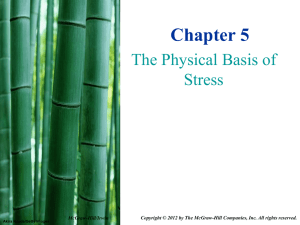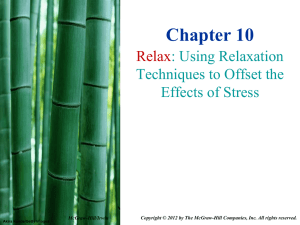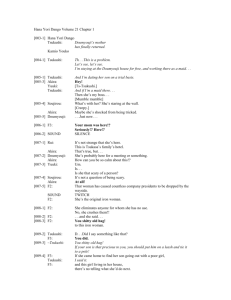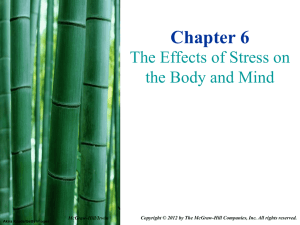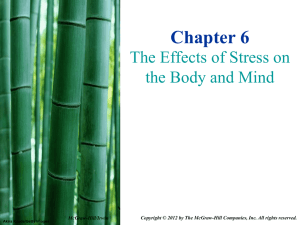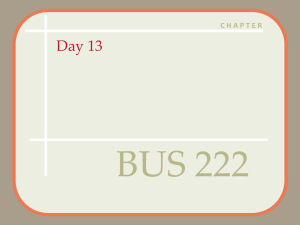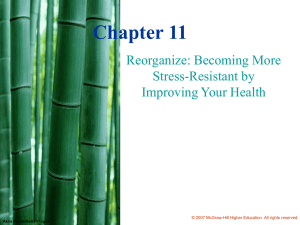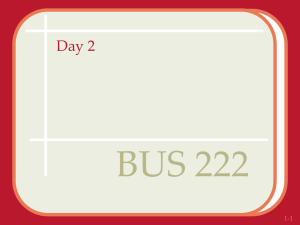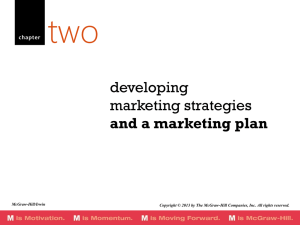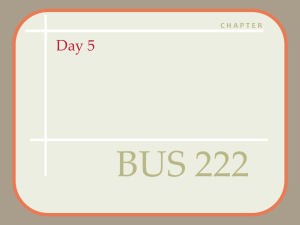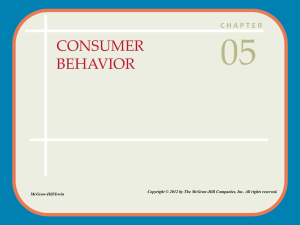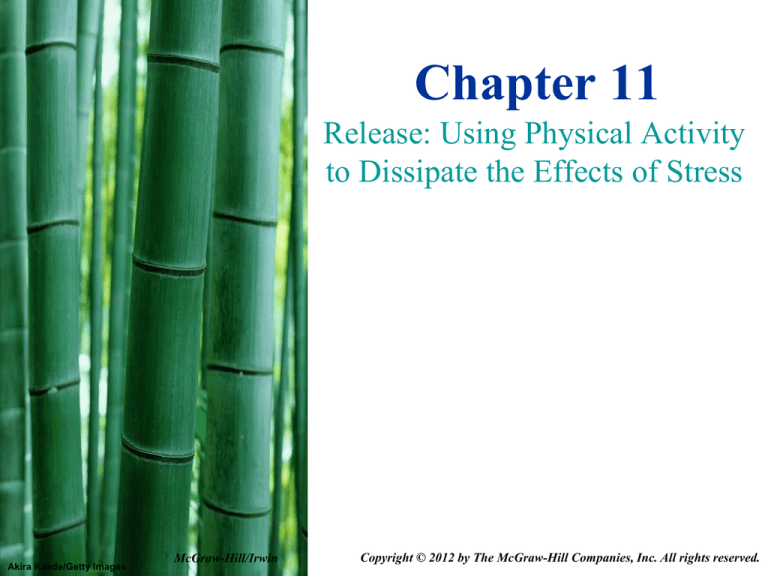
Chapter 11
Release: Using Physical Activity
to Dissipate the Effects of Stress
Akira Kaede/Getty Images
McGraw-Hill/Irwin
Copyright © 2012 by The McGraw-Hill Companies, Inc. All rights reserved.
Fight-or-Flight
Revisited
The stress response
mobilizes energy and muscle
tension
Failure to fight or flee
leaves the body in a _____
state
Tension can be relieved
constructively
11-2
Akira Kaede/Getty Images
The Health Benefits of
Exercise and Physical
Activity
There are many physiological
and psychological benefits
associated with exercise and
physical activity
Lifestyle changes not only benefit
an individual’s fitness level but
also are essential for effective
stress management
11-3
Akira Kaede/Getty Images
Physiological Benefits of
Exercise and Physical
Activity
________ reduction
________ utilization
________ utilization
Enhanced ______________
function
11-4
Akira Kaede/Getty Images
Psychological Benefits of
Exercise and Physical
Activity
Release of neuropeptide and
amine neurotransmitters
Enhanced self-esteem and selfimage
Increased creativity and
concentration
Reduced anxiety and improved
outlook on life
11-5
Akira Kaede/Getty Images
The Effects of Physical
Activity on Stress
All physical activity has the ability to
dissipate the _______ tension and
circulating hormones that are a
potentially harmful by-product of the
stress response
These stress by-products can make
us feel on edge and make it difficult
to perform activities ranging from
____________to _____________
11-6
Akira Kaede/Getty Images
Mild, Moderate, and
Vigorous Physical Activity
One way to categorize physical
activity is by the type and amount of
energy they use
__________exercise: activities that
extend beyond 4 minutes of
continuous moderate performance,
producing energy with oxygen
__________exercise: short-term,
intensive bursts of activity lasting no
longer than about 90 seconds
11-7
Akira Kaede/Getty Images
Adjusting the Level of
Physical Activity
It is relatively easy to moderate
the level of most forms of
physical activity and exercise by
changing the FIT variables
The acronym FIT stands for
F__________
I___________
T________
11-8
Akira Kaede/Getty Images
The Effects of Mild Physical
Activity on Stress
Several classic stress management
techniques involve mild physical
activity to release the muscle tension
associated with stress
You can learn and practice them on
your own, but many people find
taking classes with others to be quite
enjoyable
Instructions for getting started with
each technique are included in the
text
11-9
Akira Kaede/Getty Images
Progressive Muscle
Relaxation
Developed by Edmund
Jacobson, a Chicago physician,
to relax the muscles of
presurgical patients
Discovered the technique also
relaxed the mind and the
activities of the internal organs
11-10
Akira Kaede/Getty Images
Yoga and Stretching
Most of us do not fully stretch our
muscles daily
The result is chronically
shortened muscles, tendons, and
ligaments
This causes a restricted range
of motion, fatigue, pain, and
spasms
11-11
Akira Kaede/Getty Images
Massage
Massage relieves muscle
tension and stimulates
circulation
Massage is used by athletes,
trainers, and sports medicine
specialists to prevent and treat
soft-tissue injuries and speed the
healing process
11-12
Akira Kaede/Getty Images
Massage (Cont’d)
Types of massage
Swedish massage
Total body massage
Shiatsu massage
Combines accupressure and
massage
Medical/sports massage
Improves blood flow to a specific
area
11-13
Akira Kaede/Getty Images
Sexuality and
Massage
Massage is sensual?
Massage is not an
inherently sexual activity,
although it can be used
that way
11-14
Akira Kaede/Getty Images
How to Give a
Massage
Suggestions for preparation
(e.g., obtaining oils or powders)
and performance (e.g., having
enough room to get completely
around the person without
having to lean on or jump over
him or her; types of strokes;
how to massage feet) of
massage are given in the text
11-15
Akira Kaede/Getty Images
The Effects of Moderate
Physical Activity on
Stress
Surgeon General’s Report on
Physical Activity recommends 3060 minutes of moderate physical
activity daily
Uses roughly 150 calories daily or
1000 calories weekly
Helps offset the stress response
Reduces risk of premature
disability and death
11-16
Akira Kaede/Getty Images
Laughter as a Form of
Moderate Physical
Activity
Laughter creates a
physiological state that is
incompatible with stress
Laughter, like physical exercise,
releases endorphins
Laughter enhances the
immune-system functions
11-17
Akira Kaede/Getty Images
Which Type of Moderate
Physical Activity is Best?
All forms of moderate physical activity
counter the effects of stress in three
ways:
They fully contract and relax tense
muscles
They use the energy mobilized during
the stress response in a productive
way
They shift our attention away from our
problems and onto something we
enjoy
The best form of moderate activity to
use is the one you enjoy and are most
likely to do on a regular basis
11-18
Akira Kaede/Getty Images
The Effects of Vigorous
Physical Activity on Stress
Increase intensity for greater
release
Increased speed
Increased resistance
Increased duration
Increase your intensity
systematically over time
11-19
Akira Kaede/Getty Images
Cathartic Release Activities
and Stress
Catharsis: a purification or
purging that brings about spiritual
renewal or physical release from
tension
There is a cathartic effect that
comes with vigorous physical
activities such as
driving a golf ball
punching/kicking a heavy bag
cardio kickboxing
11-20
Akira Kaede/Getty Images

